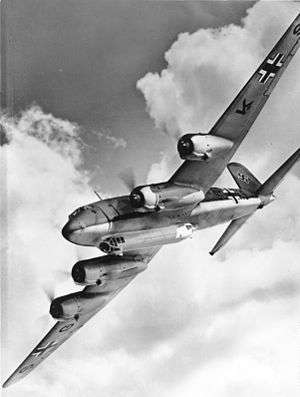Convoy HG 53
| Convoy | |||||||
|---|---|---|---|---|---|---|---|
| Part of World War II | |||||||
| |||||||
| Belligerents | |||||||
|
|
| ||||||
| Commanders and leaders | |||||||
| KL Nicolai Clausen | R Adm. OH Dawson | ||||||
| Strength | |||||||
|
1 U-boat 5 bombers 1 heavy cruiser |
21 merchant ships 2 escorts | ||||||
| Casualties and losses | |||||||
| 1 bomber | 9 merchant ships sunk (15,217 tons) | ||||||
Convoy HG 53 was the 53rd of the numbered series of World War II convoys of Homeward bound merchant ships from Gibraltar to Liverpool.[1] Convoy HG 53 lost nine ships during a coordinated attack in February 1941. HG 53 was one of the few Atlantic convoys to have ships sunk by submarines, by aircraft, and by surface ships.
Background
Twenty-one ships departed Gibraltar on 6 February 1941 bound for Liverpool and escorted by the V and W-class destroyer Velox and the Grimsby-class sloop HMS Deptford. The convoy commodore was Rear Admiral Sir OH Dawson aboard Dagmar.[2]
Action

While southbound to African waters[3] on the evening of 8 February German Type IX submarine U-37 sighted the convoy southwest of Cape St. Vincent and torpedoed the British freighters Courland and Estrellano after midnight.[4] U-37 reported the convoy to Bordeaux-Mérignac Air Base and commenced shadowing the convoy providing beacon signals for Kampfgeschwader 40. Five Focke-Wulf Fw 200 Condor bombers took off at dawn and found the convoy at noon 400 miles (640 km) southwest of Lisbon. The Fw 200s bombed from an altitude of 150 feet (46 m) because they lacked bombsights. Each fight mechanic fired at their target ship with a ventral machine gun during the approach to discourage anti-aircraft gunners; but one of the bombers was hit in a wing fuel tank[5] and crash-landed in Spain when fuel was exhausted on the return trip.[3] Six of the twenty bombs dropped hit ships,[5] sinking the convoy commodore's freighter Dagmar, the Norwegian freighter Tejo, and British freighters Britannic, Jura, and Varna. U-37 sank the British freighter Brandenburg after dark and continued sending beacon signals for the German cruiser Hipper. Hipper found and sank the straggling British freighter Iceland on 11 February.[4]
Aftermath
Hipper was distracted from further search by finding convoy SL 64 and sinking seven ships from that unescorted convoy.[4] The escort of convoy HG 53 was reinforced by the Grimsby-class sloop HMS Londonderry on 18 February, by the F-class destroyer Fury on 20 February, and by the S-class destroyer Sabre, the Town-class destroyer Leamington, and the Flower-class corvette HMS Anemone from convoy OG 53 on 22 February. The surviving 12 ships of convoy HG 53 arrived in Liverpool on 24 February 1941. Nine ships totaling 15,217 GRT had been sunk.[2]
Merchant ships in convoy
| Name[2] | Flag | Casualties[6] | Tonnage (GRT) | Cargo | Sunk by... |
|---|---|---|---|---|---|
| Brandenburg | 23 | 1,473 | Ore | U-37 | |
| Britannic II | 1 | 2,490 | Ore | KG 40 | |
| Courland | 30 | 1,325 | General | U-37 | |
| Coxwald | 1,124 | Scrap iron | |||
| Dagmar I | 5 | 2,471 | Oranges | KG 40 | |
| Dago | 1,757 | Oranges | |||
| Disa | 2,002 | Ore | |||
| Egyptian Prince | 3,490 | Oranges | |||
| Empire Lough | 2,824 | Ore | |||
| Empire Tern | 2,479 | Ore | |||
| Empire Warrior | 1,306 | Ore | |||
| Estrellano | 6 | 1,982 | General | U-37 | |
| Iceland | 1,236 | Oranges | Hipper | ||
| Jura | 17 | 1,759 | Ore | KG 40 | |
| Marklyn | 3,090 | Ore | |||
| Ousel | 1,533 | Ore | |||
| Sally Maersk | 3,252 | General | |||
| Tejo | 4 | 967 | General | KG 40 | |
| Vanellus | 1,886 | Ore | |||
| Varna | 1,514 | Pit props | KG 40 | ||
| Wrotham | 1,884 | Ore |
See also
Notes
Sources
- Bekker, Cajus (1964). The Luftwaffe War Diaries. New York: Ballantine Books.
- Blair, Clay (1996). Hitler's U-Boat War — The Hunters 1939-1942. Random House. ISBN 0-394-58839-8.
- Hague, Arnold (2000). The Allied Convoy System 1939-1945. Naval Institute Press. ISBN 1-55750-019-3.
- Rohwer, J.; Hummelchen, G. (1992). Chronology of the War at Sea 1939-1945. Naval Institute Press. ISBN 1-55750-105-X.